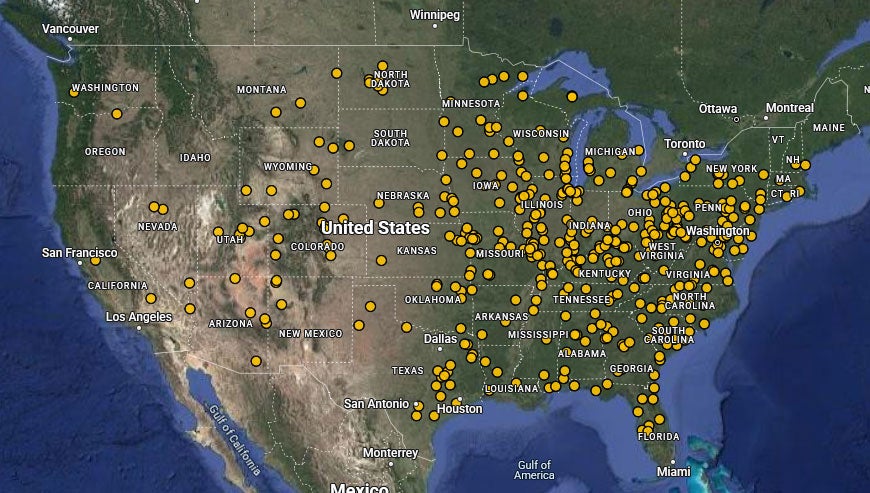April 17, 2025
Where are Coal Ash Dump Sites?
Use this map to understand where coal ash is stored near you
This map displays power plant sites across the country with coal ash dump sites.
For decades, utilities dumped coal ash — the hazardous substance left after burning coal for energy — in unlined ponds, landfills, and mines where toxic pollution continues to leak into water and soil.
Across the U.S., immense coal ash dumps are leaking hazardous chemicals. Exposure to the chemicals found in coal ash — such as arsenic, chromium, lead, lithium, and radium — is linked to increased risk of numerous types of cancer, heart and thyroid disease, respiratory illness, neurological harm, and other serious health problems. In 2023, the Environmental Protection Agency acknowledged that coal ash is even more dangerous than we thought.
Coal Ash Analysis by State
Learn about groundwater contamination from coal ash in 39 states and Puerto Rico.
Since 2006, Earthjustice has partnered with communities across the U.S. to hold coal-fired power plant operators responsible for their reckless disposal of coal ash.
Despite coal ash’s significant threats to our health and the environment, the utility industry obstructed efforts to establish coal ash protections and used deceptive tactics to evade responsibility for cleaning up dump sites. Regulations requiring clean-up have been on the books since 2015, but as a result of decades of inaction, monitoring by coal plants show coal ash is contaminating water at dangerous levels at nearly every current and former coal plant site in the country.
Coal ash remains one of our nation’s largest toxic industrial waste streams. U.S. coal plants continue to produce approximately 70 million tons of coal ash every year. In 2023, the EPA designated coal ash a national enforcement priority, acknowledging widespread noncompliance with federal coal ash regulations. The EPA found that many plants are illegally closing coal ash ponds with toxic ash sitting in groundwater, threatening sources of drinking water and the health of nearby residents.
The longer industry delays, the more toxic waste enters our water, and the more difficult cleanup becomes. But Trump’s EPA seems intent on gutting coal ash safeguards.
Years of litigation and grassroots activism led to federal monitoring and cleanup requirements for hundreds of coal ash dumps that have been leaking toxic pollution into groundwater.
This map displays information reported by the coal power industry, as required by EPA. The above map may underestimate the number of ash dumps and the presence of coal ash contamination. Many plants stopped burning coal long before EPA began to collect data, and sites where coal ash has been fully or partially excavated may still be contaminated. In 2024, EPA began requiring power companies to publicly report, often for the first time, on legacy coal ash ponds — old ponds at plants that retired before 2015. Industry reports reveal over 60 million cubic yards of this type of coal ash at 19 former power plant sites so far (of 84 power plants expected to report). The inspection reports detail coal ash dumps leaking toxic chemicals on the banks of rivers, lakes, and even a reservoir, some of which are popular fishing areas. Many operating power plants on the map will not begin publicly reporting on the size and condition of their older coal ash dumps until 2026.
The Fight Ahead to Clean Up Coal Ash
Lee Zeldin had not even been sworn in yet as Administrator of the EPA when power companies sent him their wish list. Among other things, they are asking EPA to allow power plants to leave coal ash sitting in groundwater, a clear threat to communities and drinking water, and to gut the rules for containment and cleanup of coal ash. But the courts have consistently ruled against industry and declared that these safeguards are necessary to protect human health and the environment. We successfully defended these safeguards in court and will do so again.
EPA must require effective cleanup of coal ash before communities are irreparably harmed. The companies that profited from burning coal for decades must not be allowed to walk away from more than 1,000 coal ash dumps leaking toxic waste into groundwater and surface water. Utilities and the coal power industry must stop the flow of toxic releases from leaking coal ash dumps.
About this map: The map displays the locations of 449 current and former coal plants with coal ash dumps. The dumps were identified using data gathered by EPA and self-reported by the coal industry, specifically:
- EPA datasets used in 2007 and 2014 coal ash risk assessments (Human and Ecological Risk Assessment of Coal Combustion Residuals);
- Energy Information Administration data; and
- industry self-reporting since November of 2024.
The 2007 and 2014 EPA datasets rely on industry-reported data. Ash may have been excavated from some of these historic dump sites since industry originally reported on them.
The map likely underestimates the number of ash dumps and the presence of coal ash contamination. Many plants stopped burning coal long before EPA began to collect data, and sites where coal ash has been fully or partially excavated may still be contaminated. In 2024, EPA began requiring power companies to publicly report, often for the first time, on legacy ponds — old ponds at plants that retired before 2015.
In 2026, power plants that continued to burn coal after 2015 must begin reporting on coal ash ponds that were closed and older piles/landfills on the property that were no longer receiving coal ash. More detailed information on those coal ash dumps that have been monitored since 2015 is also available.
Earthjustice fights in the courts for a long-term solution to the toxic menace of coal ash. And we act on behalf of dozens of clients and over 100 coalition partners to defeat legislative attempts to subvert federally enforceable safeguards of coal ash.
Earthjustice’s Clean Energy Program uses the power of the law and the strength of partnership to accelerate the transition to 100% clean energy.
